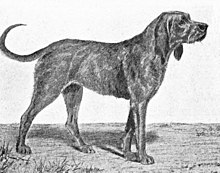
The Basset Hound is a short-legged breed of dog in the hound family. The Basset is a scent hound that was originally bred for the purpose of hunting hare. Their sense of smell and ability to ground-scent is second only to the Bloodhound.

Scent hounds are a type of hound that primarily hunts by scent rather than sight. These breeds are hunting dogs and are generally regarded as having some of the most sensitive noses among dogs. Scent hounds specialize in following scent or smells. Most of them tend to have long, drooping ears and large nasal cavities to enhance smell sensitivity. They need to have relatively high endurance to be able to keep track of scent over long distances and rough terrain. It is believed that they were originally bred by the Celts.

A hunting dog is a canine that hunts with or for hunters. There are several different types of hunting dog developed for various tasks and purposes. The major categories of hunting dog include hounds, terriers, dachshunds, cur type dogs, and gun dogs. Further distinctions within these categories can be made, based upon the dog's skills and capabilities. They are usually larger and have a more sensitive smell than normal dogs.
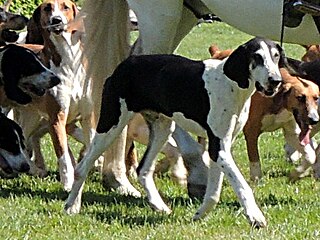
The Chien Français Blanc et Noir is a breed of dog of the scenthound type, originating in France. The breed is used for hunting in packs and descends from the old Hound of Saintonge type of large hunting dog.
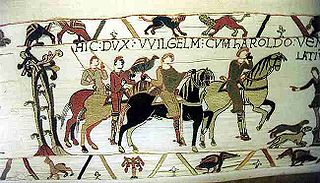
Throughout Western Europe in the Middle Ages, humans hunted wild animals. While game was at times an important source of food, it was rarely the principal source of nutrition. All classes engaged in hunting, but by the High Middle Ages, the necessity of hunting was transformed into a stylized pastime of the aristocracy. More than a pastime, it was an important arena for social interaction, essential training for war, and a privilege and measurement of nobility.
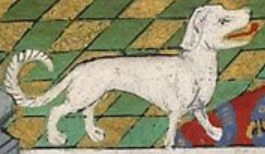
The Talbot was a type of hunting hound common in England during the Middle Ages. It is depicted in art of the period as small to medium-sized, white in colour, with short legs, large powerful feet, a deep chest with a slender waist, long drooping ears, and a very long curled tail. It is shown in one well-known example at Haddon Hall with a fierce facial expression. It is now extinct, but is believed to be an ancestor of the modern Beagle and Bloodhound. It is uncertain whether it was a scenthound, a sighthound, or a dog used for digging out quarry, nor is it known what type of quarry it hunted, whether deer, fox, boar, etc.

The Artois Hound is a rare breed of dog, and a descendant of the Bloodhound. A scent hound 22–23 inches high at the withers, weighing anything between 55 and 65 pounds, it is a well constructed dog with a slow graceful gait. It has a large, strong head, a medium-length back and a pointed tail that tends to be long and sickle-shaped. Their ears are set at eye level; they have large prominent eyes and quite thick lips.
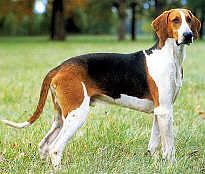
The Anglo-Français de Petite Vénerie is a medium-sized breed of dog used in hunting as a scenthound, usually in packs. It is one of the Anglo-French hound breeds which were created by crossing French scenthounds with English foxhounds. The name Petite Vénerie does not mean that dogs of the breed are petite or small, but rather that it is used to hunt small game.

The Chien Français Tricolore translated into English as the French Tricolour Hound, is a breed of dog of the scenthound type, originating in France. The breed is used for hunting in packs.
The Majestic Tree Hound is a relatively modern variety of crossbred dog, belonging to the coonhound/bloodhound group. It is a large breed, with males averaging over 100 pounds. They have long low-set earage, heavy flew, and dewlap similar to their ancestors from the Ardennes. They carry more excess skin on average than the American Blue Gascon Hound. As a modern crossbreed, it is not formally recognized by the Fédération Cynologique Internationale.

The Basset Artésien Normand is a short legged hound type dog developed in France. The word basset refers to short-legged hounds.

Anglo-Français and Français hounds are a general dog type of hunting dog that include ancient French hounds and breeds created by mixing the French dogs with English (Anglo) Foxhounds. There are seven dog breeds that are described as Anglo-Français and Français hounds.

The Griffon Nivernais is a breed of dog of the scenthound type, originating in France. It is a versatile hunting dog, used on small and large game, in packs or individually. Today's breed is a reconstruction of an ancient type of dog from the Nivernais region.

The bloodhound is a large scent hound, originally bred for hunting deer, wild boar and, since the Middle Ages, for tracking people. Believed to be descended from hounds once kept at the Abbey of Saint-Hubert, Belgium, in French it is called, le chien de Saint-Hubert.
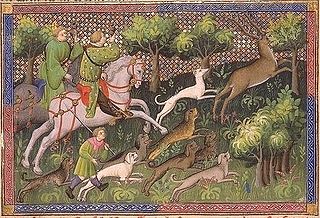
Rache, also spelled racch, rach, and ratch, from Old English ræcc, linked to Old Norse rakkí, is an obsolete name for a type of hunting dog used in Great Britain in the Middle Ages. It was a scenthound used in a pack to run down and kill game, or bring it to bay. The word appears before the Norman Conquest. It was sometimes confused with 'brache', which is a French derived word for a female scenthound.
A limer, or lymer, was a kind of dog, a scenthound, used on a leash in medieval times to find large game before it was hunted down by the pack. It was sometimes known as a lyam hound/dog or lime-hound, from the Middle English word lyam, meaning 'leash'. The French cognate limier has sometimes been used for the dogs in English as well. The type is not to be confused with the bandog, which was also a dog controlled by a leash, typically a chain, but was a watchdog or guard dog.

The Poitevin, also known as the Chien de Haut-Poitou, is a breed of French scenthound from the province of Poitou, this predominantly pack hound was created in the 17th century to hunt wolves.

The Grand Fauve de Bretagne was a breed of scenthound from Brittany used to hunt wolves and wild boar. The Grand Fauve de Bretagne were large rough-coated hounds, their coats were short, dense and harsh, and they were a uniform pale golden-brown in colour. Grand Fauve de Bretagnes were renowned for their unruly natures, being very difficult to control; their temperament suited them for hunting dangerous game like wolf and wild boar, but due to their unruliness they were also known to kill sheep and goats against their huntsman's wishes.

The King's White Hound, the Chien Blanc du Roi in French, was a now extinct breed of scent hound from France. The breed was said to be the favourite of the French kings from Louis XI to Louis XIV.

Bassets are a sub-type of scenthound deliberately bred with short legs, that are used for hunting where the hunters accompany the hunting hounds on foot.
